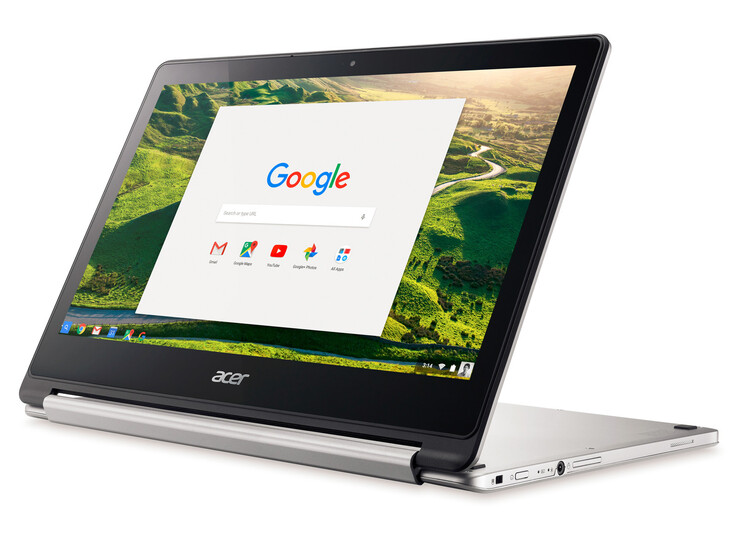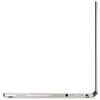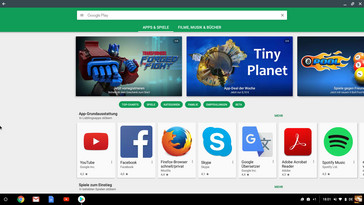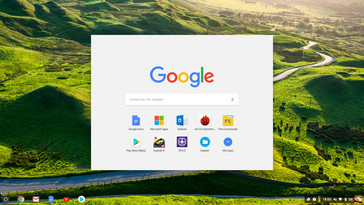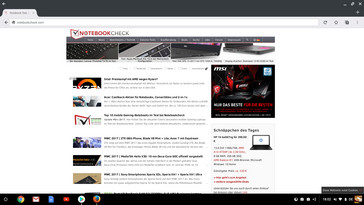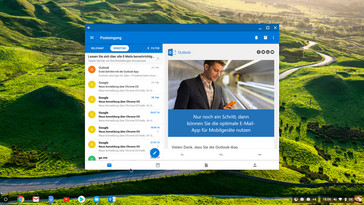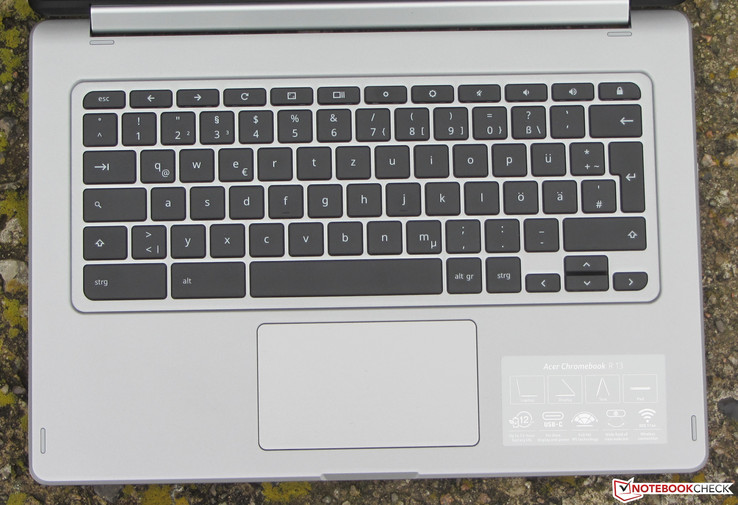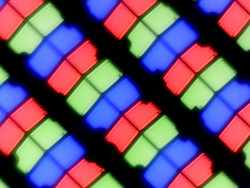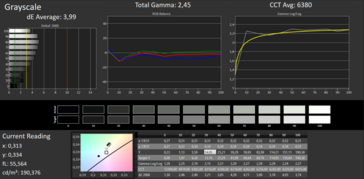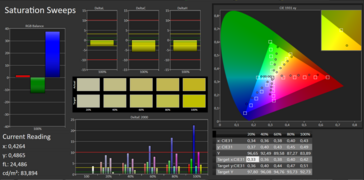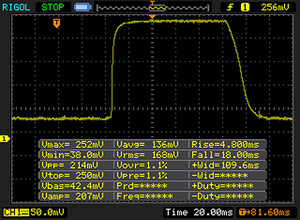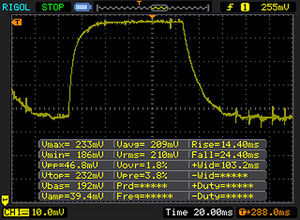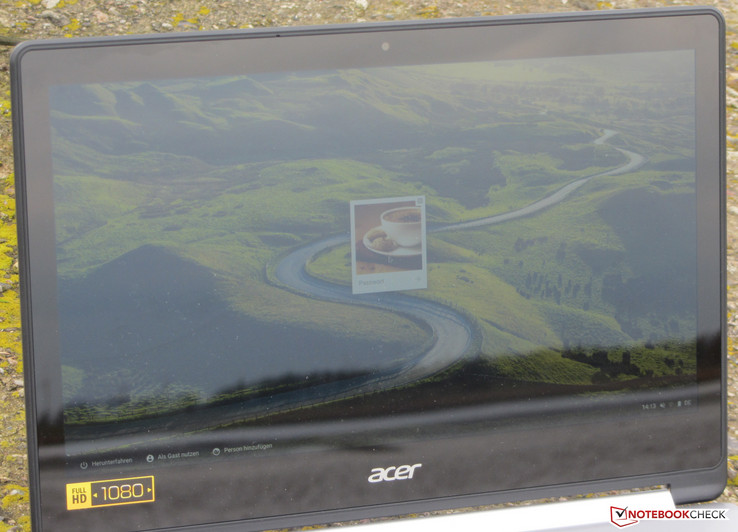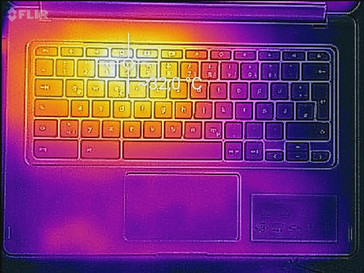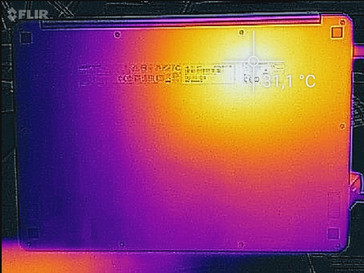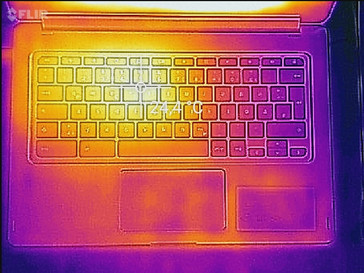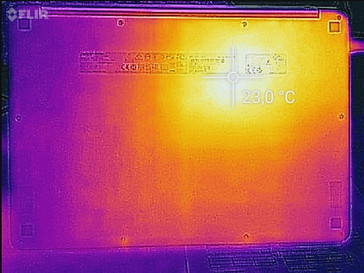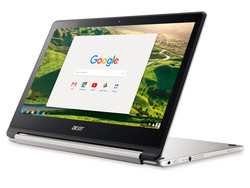Acer Chromebook R13 CB5-312T-K0YK Convertible Review

For the original German review, see here.
The simplicity of Chromebooks is pleasing: Open, log in and get started. Users do not have to fuss with the laptop's software or configuration. Acer now has the 13.3-inch Chromebook R13 convertible in its portfolio. The installed touchscreen will first prove its practicality when Android apps can be used officially on the Chromebook R13. The Chromebook competes against devices such as HP's Chromebook 13 G1 Core m5, Acer's Swift 1, HP's Stream 13, HP's Stream 13 and Lenovo's E31-70.
Case and Connectivity
Acer's Chromebook proves that using metal does not automatically mean a solid casing. The base unit can be dented in the usual places (on both keyboard sides, below the touchpad). Furthermore, it is easy to twist. This is also true of the lid. At least this does not cause image distortions, even when pressure is applied to the lid's back. The use of aluminum primarily makes the Chromebook look stylish, but it does not contribute to the devices robustness.
The laptop features a USB 3.1 Gen1 port (Type-C) for connecting the power supply. It can, however, also be used for connecting USB peripherals. A monitor can also be connected. However, a Type-C USB-to display-port adapter would be needed (not included). The addition of another video-out to the already existing HDMI port in the Chromebook would enhance the device significantly.
The installed Wi-Fi module supports the fast ac-standard (2.4 and 5 GHz). Acer relies on a solution with two antennas (2x2 MIMO).
Android Apps @ Chromebook
Acer's Chromebook R13 is on the 2017 list of devices that can be equipped with Android apps from Google's Play Store. At the time of our test, no corresponding Chrome OS update was available. However, a beta version of Chrome OS that allows using Android apps can be installed via the beta channel. Naturally, we tried this out: The use and installation of these apps functioned mostly smoothly. We ran some Android benchmarks using the Chrome OS. However, not all apps are yet ready for use with the Chrome OS. For example, MS Word and MS Excel cannot be installed. Some apps cannot be used via the keyboard - the game "Asphalt 8: Airborne" is an example. And this is where the touchscreen in the Chromebook R13 becomes useful.
Input Devices
Acer's Chromebook is equipped with an unlit chiclet keyboard. The flat, roughened keys have a medium drop. The pressure point is rather spongy and the keys' resistance could be crisper. The keyboard yields slightly when typing on it. Acer delivers a keyboard designed for home use; prolific typists will not be happy with it. The installed ClickPad replaces a mouse. It has an area of approximately 10.5 x 6 cm (~4.1 x 2.4 in). Its sleek surface allows the fingers to glide easily. The pad has a short drop and clear pressure point.
The touchscreen supports 10 touch points. It did not cause any problems and responded quickly to inputs. The screen can be used with the fingers or an active stylus.
Display
| |||||||||||||||||||||||||
Brightness Distribution: 88 %
Center on Battery: 194 cd/m²
Contrast: 835:1 (Black: 0.23 cd/m²)
ΔE Greyscale Calman: 3.99 | ∀{0.09-98 Ø5}
Gamma: 2.45
CCT: 6380 K
| Acer Chromebook R13 CB5-312T-K0YK IPS, 1920x1080, 13.3" | HP Chromebook 13 G1 Core m5 3200x1800, 13.3" | Acer Swift 1 SF114-31-P6F6 TN LED, 1366x768, 14" | Lenovo E31-70 80KX015RGE TN, 1366x768, 13.3" | Acer Aspire ES1-332-P91H TN LED, 1366x768, 13.3" | HP Stream 13-c102ng TN, 1366x768, 13.3" | |
|---|---|---|---|---|---|---|
| Display | ||||||
| Display P3 Coverage (%) | 40.97 | 49.25 | 44.72 | 40.68 | ||
| sRGB Coverage (%) | 61.5 | 73.5 | 67.3 | 59.8 | ||
| AdobeRGB 1998 Coverage (%) | 42.35 | 50.9 | 46.2 | 42.32 | ||
| Response Times | -20% | -7% | -3% | -17% | -14% | |
| Response Time Grey 50% / Grey 80% * (ms) | 38 ? | 39.2 ? -3% | 32 ? 16% | 44.4 ? -17% | 39 ? -3% | 45 ? -18% |
| Response Time Black / White * (ms) | 23 ? | 31.6 ? -37% | 30 ? -30% | 20.4 ? 11% | 30 ? -30% | 25 ? -9% |
| PWM Frequency (Hz) | 1389 ? | 200 ? | 200 ? | 1000 ? | 201 ? | |
| Screen | -26% | -60% | -66% | -67% | -42% | |
| Brightness middle (cd/m²) | 192 | 355.5 85% | 270 41% | 206 7% | 255 33% | 190 -1% |
| Brightness (cd/m²) | 204 | 330 62% | 247 21% | 200 -2% | 232 14% | 179 -12% |
| Brightness Distribution (%) | 88 | 90 2% | 80 -9% | 84 -5% | 82 -7% | 85 -3% |
| Black Level * (cd/m²) | 0.23 | 0.804 -250% | 0.57 -148% | 0.6 -161% | 0.52 -126% | 0.33 -43% |
| Contrast (:1) | 835 | 442 -47% | 474 -43% | 343 -59% | 490 -41% | 576 -31% |
| Greyscale dE 2000 * | 3.99 | 4.35 -9% | 12.73 -219% | 10.94 -174% | 15.01 -276% | 10.32 -159% |
| Gamma | 2.45 90% | 2.35 94% | 2.36 93% | 2.76 80% | 2.41 91% | 2.48 89% |
| CCT | 6380 102% | 6269 104% | 14629 44% | 13282 49% | 24382 27% | 11884 55% |
| Colorchecker dE 2000 * | 3.75 | 3.01 | 9.2 | 13.12 | 9.84 | |
| Colorchecker dE 2000 max. * | 7.15 | 6.33 | 14.8 | 22.98 | ||
| Color Space (Percent of AdobeRGB 1998) (%) | 39 | 46.92 | 43 | 38 | ||
| Color Space (Percent of sRGB) (%) | 62 | 73.36 | 68 | 60 | ||
| Total Average (Program / Settings) | -23% /
-25% | -34% /
-46% | -35% /
-50% | -42% /
-55% | -28% /
-35% |
* ... smaller is better
Screen Flickering / PWM (Pulse-Width Modulation)
| Screen flickering / PWM not detected | ||
In comparison: 53 % of all tested devices do not use PWM to dim the display. If PWM was detected, an average of 8125 (minimum: 5 - maximum: 343500) Hz was measured. | ||
Display Response Times
| ↔ Response Time Black to White | ||
|---|---|---|
| 23 ms ... rise ↗ and fall ↘ combined | ↗ 5 ms rise | |
| ↘ 18 ms fall | ||
| The screen shows good response rates in our tests, but may be too slow for competitive gamers. In comparison, all tested devices range from 0.1 (minimum) to 240 (maximum) ms. » 50 % of all devices are better. This means that the measured response time is worse than the average of all tested devices (20.2 ms). | ||
| ↔ Response Time 50% Grey to 80% Grey | ||
| 38 ms ... rise ↗ and fall ↘ combined | ↗ 14 ms rise | |
| ↘ 24 ms fall | ||
| The screen shows slow response rates in our tests and will be unsatisfactory for gamers. In comparison, all tested devices range from 0.165 (minimum) to 636 (maximum) ms. » 54 % of all devices are better. This means that the measured response time is worse than the average of all tested devices (31.6 ms). | ||
Performance
Acer's Chromebook R13 is a 13.3-inch convertible. Our review sample is priced at approximately 400 Euros (~$425). Other configurations were not available at the time of testing.
Processor
A passively cooled MT8173C SoC from MediaTek is inside the Chromebook. This ARM SoC has a total of four CPU cores: Two Cortex A72 and two Cortex A53 cores that create the so-called big.LITTLE array. Here, two high-performance cores (A72; max. 2.1 GHz) and two energy-saving cores (A53; max. 1.7 GHz) are combined to ensure that the highest possible performance is available when required, but the battery is not depleted in idle mode or low load. It is also possible to use all four cores simultaneously, so that this is a genuine quad-core processor.
| Geekbench 4.0 | |
| 64 Bit Single-Core Score | |
| Acer Aspire ES1-332-P91H | |
| Acer Chromebook R13 CB5-312T-K0YK | |
| Acer Swift 1 SF114-31-P6F6 | |
| 64 Bit Multi-Core Score | |
| Acer Aspire ES1-332-P91H | |
| Acer Swift 1 SF114-31-P6F6 | |
| Acer Chromebook R13 CB5-312T-K0YK | |
| Sunspider - 1.0 Total Score | |
| Acer Chromebook R13 CB5-312T-K0YK | |
| HP Stream 13-c102ng | |
| Acer Aspire ES1-332-P91H | |
| HP Chromebook 13 G1 Core m5 | |
| JetStream 1.1 - Total Score | |
| HP Chromebook 13 G1 Core m5 | |
| Lenovo E31-70 80KX015RGE | |
| Acer Aspire ES1-332-P91H | |
| Acer Swift 1 SF114-31-P6F6 | |
| Acer Chromebook R13 CB5-312T-K0YK | |
| Mozilla Kraken 1.1 - Total | |
| Acer Swift 1 SF114-31-P6F6 | |
| Acer Chromebook R13 CB5-312T-K0YK | |
| Acer Aspire ES1-332-P91H | |
| HP Chromebook 13 G1 Core m5 | |
| Octane V2 - Total Score | |
| HP Chromebook 13 G1 Core m5 | |
| Acer Aspire ES1-332-P91H | |
| Acer Chromebook R13 CB5-312T-K0YK | |
| Acer Swift 1 SF114-31-P6F6 | |
| WebXPRT 2015 - Overall | |
| HP Chromebook 13 G1 Core m5 | |
| Acer Aspire ES1-332-P91H | |
| Acer Chromebook R13 CB5-312T-K0YK | |
* ... smaller is better
System Performance
The system runs smoothly, and we did not encounter any problems. The Chrome OS boots within seconds and applications launch quickly.
Storage Device
An eMMC module with a capacity of 32 GB serves as the system drive. The storage capacity can be expanded via a microSD card when required.
Graphics Card
The PowerVR GX6250 GPU is responsible for video output. The graphics core has been on the market since mid-2014 and is consequently not one of the latest models. It reaches speeds of up to 700 MHz, and the integrated decoder unloads the processor when playing videos. H.264, H.265/HEVC, and VP-9 formats are supported.
| 3DMark - 1280x720 offscreen Ice Storm Unlimited Score | |
| Acer Aspire ES1-332-P91H | |
| Acer Chromebook R13 CB5-312T-K0YK | |
| GFXBench (DX / GLBenchmark) 2.7 | |
| 1920x1080 T-Rex Offscreen | |
| Acer Aspire ES1-332-P91H | |
| Acer Chromebook R13 CB5-312T-K0YK | |
| T-Rex Onscreen | |
| Acer Aspire ES1-332-P91H | |
| Acer Chromebook R13 CB5-312T-K0YK | |
| GFXBench 3.0 | |
| 1920x1080 1080p Manhattan Offscreen | |
| Acer Aspire ES1-332-P91H | |
| Acer Chromebook R13 CB5-312T-K0YK | |
| on screen Manhattan Onscreen OGL | |
| Acer Aspire ES1-332-P91H | |
| Acer Chromebook R13 CB5-312T-K0YK | |
| GFXBench 3.1 | |
| 1920x1080 Manhattan ES 3.1 Offscreen | |
| Acer Aspire ES1-332-P91H | |
| Acer Chromebook R13 CB5-312T-K0YK | |
| on screen Manhattan ES 3.1 Onscreen | |
| Acer Aspire ES1-332-P91H | |
| Acer Chromebook R13 CB5-312T-K0YK | |
| GFXBench | |
| 1920x1080 Car Chase Offscreen | |
| Acer Aspire ES1-332-P91H | |
| Acer Chromebook R13 CB5-312T-K0YK | |
| on screen Car Chase Onscreen | |
| Acer Aspire ES1-332-P91H | |
| Acer Chromebook R13 CB5-312T-K0YK | |
Emissions and Energy Management
System Noise
The SoC installed in the Chromebook is cooled passively. Thus, a fan is not present. The laptop does not produce any other side noises.
Temperature
It cannot really be said that the Chromebook heats up. The laptop is lukewarm in idle mode. The temperatures do not increase much during load either. 30 degrees Celsius (~86 degrees Fahrenheit) is exceeded on only two measuring points. To simulate the stress test, we run Google's Octane V2 benchmark on a loop and play a Full HD video at the same time.
(+) The maximum temperature on the upper side is 30.6 °C / 87 F, compared to the average of 33.1 °C / 92 F, ranging from 21.6 to 53.2 °C for the class Netbook.
(+) The bottom heats up to a maximum of 29.5 °C / 85 F, compared to the average of 36.6 °C / 98 F
(+) In idle usage, the average temperature for the upper side is 21.9 °C / 71 F, compared to the device average of 29.8 °C / 86 F.
(+) The palmrests and touchpad are cooler than skin temperature with a maximum of 23.3 °C / 73.9 F and are therefore cool to the touch.
(+) The average temperature of the palmrest area of similar devices was 29.3 °C / 84.7 F (+6 °C / 10.8 F).
Speakers
A speaker is found on the left and the right of the casing. They produce a very decent sound that allows prolonged listening.
Acer Chromebook R13 CB5-312T-K0YK audio analysis
(±) | speaker loudness is average but good (73 dB)
Bass 100 - 315 Hz
(±) | reduced bass - on average 13.2% lower than median
(+) | bass is linear (5.6% delta to prev. frequency)
Mids 400 - 2000 Hz
(+) | balanced mids - only 3.2% away from median
(+) | mids are linear (6.9% delta to prev. frequency)
Highs 2 - 16 kHz
(+) | balanced highs - only 2.5% away from median
(+) | highs are linear (5.5% delta to prev. frequency)
Overall 100 - 16.000 Hz
(+) | overall sound is linear (13.9% difference to median)
Compared to same class
» 0% of all tested devices in this class were better, 14% similar, 86% worse
» The best had a delta of 14%, average was 25%, worst was 35%
Compared to all devices tested
» 15% of all tested devices were better, 4% similar, 81% worse
» The best had a delta of 4%, average was 24%, worst was 134%
Apple MacBook 12 (Early 2016) 1.1 GHz audio analysis
(+) | speakers can play relatively loud (83.6 dB)
Bass 100 - 315 Hz
(±) | reduced bass - on average 11.3% lower than median
(±) | linearity of bass is average (14.2% delta to prev. frequency)
Mids 400 - 2000 Hz
(+) | balanced mids - only 2.4% away from median
(+) | mids are linear (5.5% delta to prev. frequency)
Highs 2 - 16 kHz
(+) | balanced highs - only 2% away from median
(+) | highs are linear (4.5% delta to prev. frequency)
Overall 100 - 16.000 Hz
(+) | overall sound is linear (10.2% difference to median)
Compared to same class
» 7% of all tested devices in this class were better, 2% similar, 91% worse
» The best had a delta of 5%, average was 18%, worst was 53%
Compared to all devices tested
» 4% of all tested devices were better, 1% similar, 94% worse
» The best had a delta of 4%, average was 24%, worst was 134%
Frequency diagram in comparison (checkboxes above can be turned on/off!)
Power Consumption
The laptop does not present any irregularities in terms of energy requirement. The power consumption is on a normal level for a device from this performance category over the entire load range. The power supply has a nominal output of 45 watts.
| Off / Standby | |
| Idle | |
| Load |
|
Key:
min: | |
Battery Runtime
We simulate the load needed for opening websites via a script in our practical Wi-Fi test. The screen's brightness is set to approximately 150 cd/m². The Chromebook achieved a runtime of 12:53 hours.
Pros
Cons
Verdict
Acer's Chromebook R13 relies on ARM technology with the MT8153C SoC. The SoC allows passive cooling that is also implemented here. Thus, the Chromebook runs silently. Acer does not present a run-of-the-mill device with its Chromebook R13. It is a 13.3-inch Chromebook convertible. A touchscreen in a Chrome OS device is basically a superfluous feature. However, this will change as soon as Android apps officially run on Acer's Chromebook. A Wi-Fi module for Internet access, which supports the fast ac-standard, is installed. Furthermore, the Chromebook can serve with an outstanding battery life.
A charged battery will last the user through a workday or a day at school/university.
The laptop's metal casing is attractive primarily due to its looks, but we would expect more in terms of stability. The keyboard is sufficient for home use, but it is not designed for prolific writers. The installed IPS panel pleases with stable viewing angles and good contrast, but its brightness is too low.
Acer Chromebook R13 CB5-312T-K0YK
- 02/28/2017 v6 (old)
Sascha Mölck




